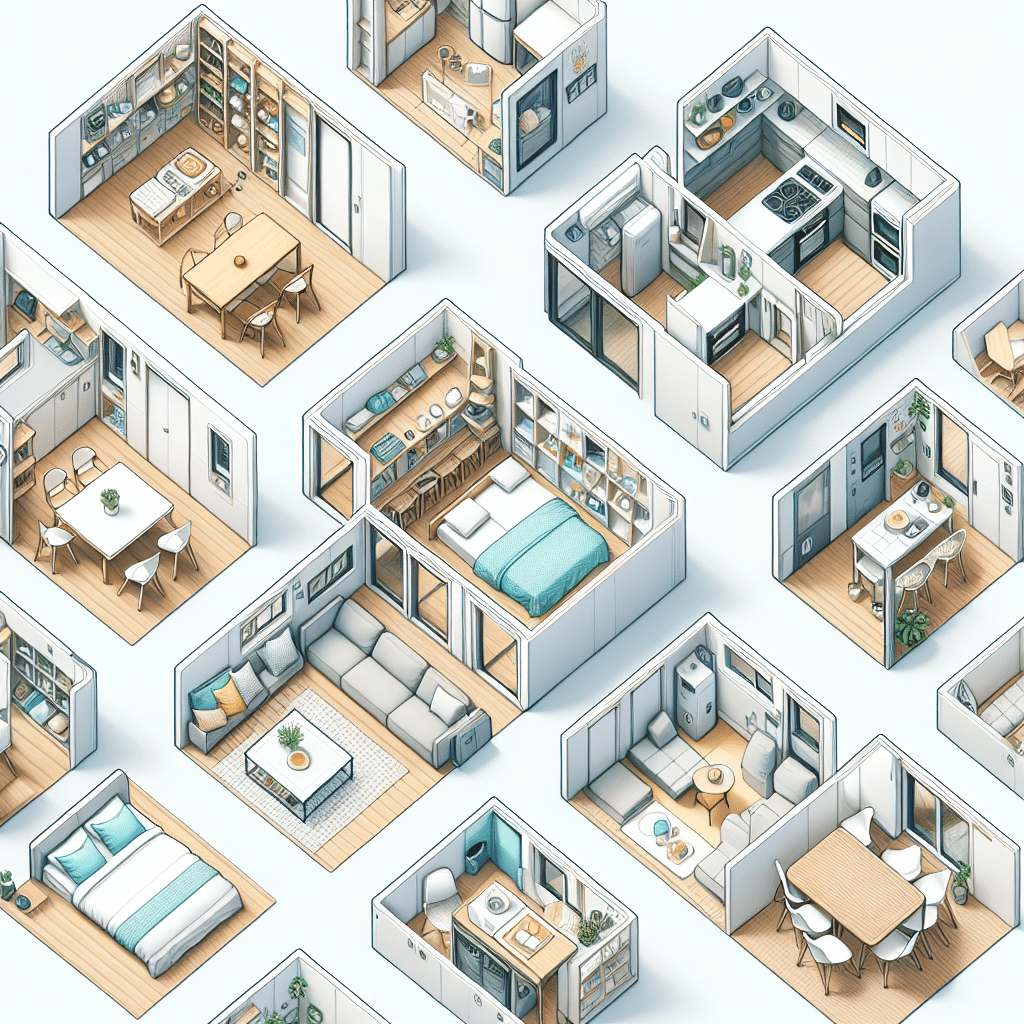Tiny Home Layout Ideas with Smart Furniture
The concept of tiny homes has rapidly gained traction in recent years, as more individuals seek sustainable living solutions that offer flexibility and affordability without compromising style or comfort. A key aspect of tiny living is the efficient use of space, which can be expertly achieved through innovative layouts and the incorporation of smart furniture. Below are some creative tiny home layout ideas that maximize functionality and aesthetic appeal while accommodating essential living needs.
1. Multi-Functional Living Areas
A primary feature of tiny home designs is the multi-functional living area. This space should serve various purposes, combining relaxation, dining, and working areas.
-
Convertible Sofa Beds: Opt for a stylish sofa that easily transforms into a bed when guests visit. Look for options with built-in storage to keep your space tidy.
-
Foldaway Dining Tables: Consider a drop-leaf or wall-mounted table that can be folded down when not in use. This can double as additional counter space in the kitchen.
-
Storage Ottomans: Utilize ottomans that open to reveal storage for blankets or books. They enhance seating options and maintain a clutter-free environment.
2. Lofted Sleeping Areas
Lofted sleeping areas take advantage of vertical space and help keep the main floor open and inviting.
-
Under-Bed Storage: Build a loft bed with ample space beneath for a desk, shelving, or even a cozy seating nook. Use storage bins or drawers to optimize accessibility.
-
Sliding Stairs: Instead of traditional stairs, use sliding stairs that can tuck away when not in use. This eliminates excess floor space while adding a visually appealing element.
-
Curtain Dividers: With curtains or sliding panels, you can create a sense of privacy around the lofted sleeping quarters, making it feel like a distinct zone.
3. Efficient Kitchen Designs
Smart kitchens in tiny homes minimize wasted space while providing essential conveniences.
-
Pull-Out Cabinets: Consider pull-out cabinets or pantry systems that maximize narrow spaces. A slim, pull-out pantry can house dry goods while keeping everything accessible.
-
Compact Applances: Choose compact, energy-efficient appliances designed for tiny living, such as slimline dishwashers, stackable washer-dryers, or microwave-ovens.
-
Wall-Mounted Pot Racks: Use wall-mounted racks for pots and pans to free up cabinet space and keep cooking essentials handy.
4. Outdoor Living Spaces
Integrating outdoor living areas extends usable space and connects residents with nature.
-
Foldable Furniture: Invest in foldable outdoor furniture, such as chairs and tables, which can be collapsed and stored easily when not in use.
-
Deck with Multi-Use Features: Design a deck that features built-in storage benches or a foldable table for dining or entertaining outdoors.
-
Vertical Gardens: Consider installing vertical garden planters along the exterior walls. This design not only beautifies the space but also helps purify the air.
5. Smart Office Nooks
Incorporating a dedicated workspace is essential, especially in the age of remote working and freelancing.
-
Wall-Mounted Desks: A wall-mounted drop-down desk can be a space-saver that adds functionality without sacrificing living space.
-
Rotating Bookcases: Use a rotating bookcase to create a mobile barrier between the workspace and living area. This offers an easy way to separate spaces when needing focus.
-
Cable Management Systems: Incorporate furniture with built-in solutions for cable management to prevent clutter and maintain a neat appearance.
6. Innovative Bathroom Solutions
Efficient bathroom layouts focus on maximizing limited square footage while ensuring all necessary amenities.
-
Corner Showers: A rounded corner shower can save space while still providing a functional area for bathing.
-
Compact Vanities: Choose a vanity with integrated shelving for toiletries, opting for a rounded or space-saving design that fits neatly in tight spaces.
-
Mirrored Cabinets: This dual-purpose furniture offers vital storage while creating the illusion of more space through reflections.
7. Modular Furniture Designs
Investing in modular furniture permits flexibility and adaptability within tiny homes.
-
Configurable Sofas: Look for modular sofas that can be rearranged as needed—this can transform a living room into a guest area effortlessly.
-
Nest Tables: Set of nest tables that stack neatly can be deployed as needed for guests or expanded workspaces, then tucked away when not in use.
-
Floating Shelves: Use lightweight floating shelves to create additional storage and display space without consuming floor space.
8. Utilization of Vertical Space
Maximizing vertical storage is crucial for tiny homes.
-
Tall Bookcases: Invest in tall bookcases reaching the ceiling for books, decor, and other items. Use the top shelf for infrequent use items.
-
Overhead Storage Bins: Install overhead storage bins or cabinets above the kitchen or living area for less frequently used items. This keeps essential items within reach while providing extra space.
-
Wall-Mounted Hooks and Racks: Use hooks for hanging coats, bags, or kitchen utensils to keep items off surfaces and within arm’s reach.
9. Eco-Friendly and Smart Furniture
Emphasizing eco-friendliness is vital in tiny home designs.
-
Sustainable Materials: Consider furniture made from reclaimed wood, bamboo, or recycled metal, providing durability and minimizing environmental impact.
-
Smart Tech Fixtures: Include smart lighting systems that can be controlled via smartphone for efficiency. LED lights are ideal for reducing energy use while offering various ambient light options.
10. Color and Design Coordination
A cohesive color scheme fosters a sense of flow in tiny homes.
-
Light Colors and Mirrors: Use light colors on walls and furniture to create an illusion of space. Mirrors can further amplify light and make rooms appear larger.
-
Consistent Textures: Utilize similar textures and materials throughout the space for continuity. This can help tie together separate areas in a tiny home seamlessly.
-
Accent Walls: Create an accent wall using bold colors or patterns to make a statement without overwhelming the space.
Implementing these tiny home layout ideas with smart furniture enables residents to live comfortably and stylishly within limited space. Through thoughtful design and innovation, tiny homes can offer all the benefits of traditional housing, fostering a lifestyle filled with functionality, creativity, and sustainability.
